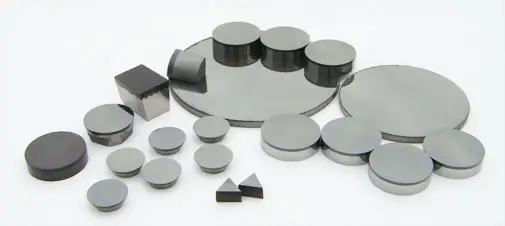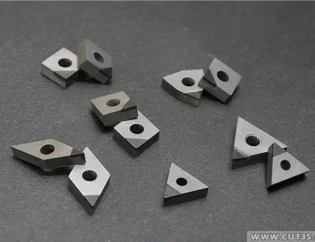Introduction to Polycrystalline Diamond
Polycrystalline diamond (PCD) is a polycrystalline material made by polymerizing diamond micropowder through metal binders (such as Co, Ni, etc.). Polycrystalline diamond is a special kind of powder metallurgy product, and some methods and means of conventional powder metallurgy are borrowed in the manufacturing method. Artificial monocrystalline diamond is gradually developed after 1950s, which is synthesized by adding catalyst to graphite as raw material and by high temperature and ultra-high pressure.
During the sintering process, due to the addition of additives, a bonding bridge is formed between the PCD crystals with Co, Mo, W, WC and Ni as the main components, and the diamond is firmly embedded in the strong skeleton formed by the bonding bridge. The role of the metal binder is to hold the diamond firmly and give full play to the cutting efficiency of diamond. In addition, because the grains are freely distributed in all directions, it is difficult for cracks to pass from one grain to another, which makes the strength and toughness of PCD greatly improved.
Features of Polycrystalline Diamond
1, ultra-high hardness and wear resistance: nature’s incomparable material hardness of 10,000 HV, wear resistance is nearly 100 times that of carbide inserts.
2, anisotropic monocrystalline diamond crystal different crystal surface and crystal direction of hardness, wear resistance, microscopic strength, grinding and processing of the degree of difficulty and friction coefficient between the workpiece material, etc. differ greatly, therefore, the design and manufacture of monocrystalline diamond tools, must correctly select the crystal direction, the diamond raw materials must be crystal orientation. The choice of front and back tool face of diamond tools is an important issue in designing single crystal diamond tools.
3, low coefficient of friction: PCD inserts in the processing of some non-ferrous materials when the coefficient of friction than other inserts are low, about half of the carbide is usually about 0.2.
4, PCD cutting edge is very sharp cutting edge blunt circle radius generally up to 0.1-0.5um. and natural single crystal diamond tools can be in the range of 0.002-0.005um. Therefore, natural diamond tools can carry out ultra-thin cutting and ultra-precision machining.
5, low coefficient of thermal expansion:diamond coefficient of thermal expansion is smaller than that of cemented carbide, about 1/10 of high-speed steel. therefore diamond tools do not produce a lot of thermal deformation, that is, the change of tool size caused by cutting heat is very small, which is especially important for precision and ultra-precision machining with high dimensional precision requirements.
PCD Diamond Tools
Machining aluminum workpieces with PCD diamond tools has the advantages of long tool life and high metal removal rate, but the disadvantage is that the tools are expensive and the machining cost is high. This point has formed a consensus in the machinery manufacturing industry. However, the development and application of PCD tools have undergone many changes in recent years. Another change of PCD tools is the continuous reduction of processing costs, in the market competition pressure and tool manufacturing process improvement Under the combined effect of competitive market pressure and tool manufacturing process improvement, the price of PCD tools has dropped significantly by more than 50 percent. These trends have led to an increase in the use of PCD tools in the machining of aluminum materials, while the applicability of the tools is governed by the different materials being machined.

How to use polycrystalline diamond tools
We recommend the use of fine grain (or medium grain) PCD grade to process non-silicon and low-silicon aluminum alloy materials. Coarse grain PCD grade is used to process high silicon aluminum alloy material. If the surface finish of the workpiece processed by milling does not meet the requirements, the surface of the workpiece can be trimmed by using a trimmer insert with a smaller grain size to obtain a satisfactory surface finish.
The correct application of diamond inserts is a prerequisite to obtain satisfactory processing results. Although the specific causes of tool failure vary, they are usually due to incorrect use of the object or method of use. When ordering PCD inserts, the user should correctly grasp the tool’s range of adaptation. For example, when processing ferrous metal workpiece (such as stainless steel) with PCD inserts, as the diamond is very easy to chemical reaction with the carbon in the steel, will lead to rapid wear of PCD inserts, therefore, the correct choice for processing hardened steel should be PCBN inserts.
Generally speaking, in order to reduce the cutting force and prevent the generation of chip tumor, PCD inserts should use positive cutting angle. But in the processing of high silicon aluminum alloy (especially in the use of diamond inserts instead of carbide tools for processing), the PCD insert back angle is best than the original carbide tools used back angle (such as 250) slightly reduced, in order to improve the PCD insert cutting edge on high silicon aluminum alloy cutting performance. PCD insert positive front angle is also not too large, because the larger the tool front angle, the lower the cutting edge strength, in other words The smaller the back angle of the PCD insert, the higher the strength of the cutting edge. In order to increase the cutting edge strength as much as possible under the premise of guaranteeing the positive cutting angle of the tool, we welded the CNMX insert with negative front angle to the tip of the PCD tool and formed a positive cutting angle, so that the negative front angle of the insert provides a high cutting edge strength without affecting the normal cutting of the tool. When preparing the cutting edge of PCD inserts, it is not necessary to make too much process for the diamond tip. For PCD milling cutters, the cutting edge can be lightly sharpened, in addition, making the cutting edge produce a certain axial inclination also helps to improve the cutting performance of PCD tools.










Exelente definicion me sacaron de un monton de dudas
ग्रेसियस